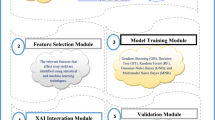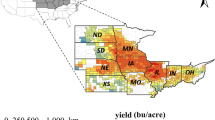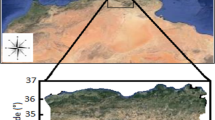Abstract
Cashew is an important cash crop which is ecologically sensitive, making it vulnerable to climate change. So, the present study compares the performance of stepwise linear regression (SLR), least absolute shrinkage and selection operator (LASSO), elastic net, and artificial neural network (ANN) individually against the ANN model combined with SLR, LASSO, elastic net, and principal components analysis (PCA) for prediction of cashew yield based on weather parameters. The model performances were evaluated using three approaches: (1) Taylor plot; (2) statistical metrics like coefficient of determination (R2), root mean square error (RMSE), and normalized RMSE (nRMSE); and (3) ranking followed by Kruskal–Wallis and Dunn’s post hoc test. The results revealed that during calibration, the R2 and RMSE ranged from 0.486 to 0.999 and 2.184 to 88.040 kg ha−1, respectively, while RMSE and nRMSE varied from 3.561 to 242.704 kg ha−1 and 0.799 to 89.949%, respectively, during validation. Kruskal–Wallis and Dunn’s post hoc test revealed LASSO as the best model which was at par with ELNET, SLR, and ELNET-ANN. So, these models can be used for cashew yield prediction for the study area well in advance.



Similar content being viewed by others
Data availability
The datasets and code generated during and/or analyzed during the current study are available from the corresponding author on reasonable request.
References
Abbaszadeh P, Gavahi K, Alipour A et al (2022) Bayesian multi-modeling of deep neural nets for probabilistic crop yield prediction. Agric for Meteorol 314:108773. https://doi.org/10.1016/j.agrformet.2021.108773
Adisa O, Botai J, Adeola A et al (2019) Application of artificial neural network for predicting maize production in South Africa. Sustainability 11:1145. https://doi.org/10.3390/su11041145
Asseng S, Ewert F, Rosenzweig C et al (2013) Uncertainty in simulating wheat yields under climate change. Nat Clim Chang 3:827–832
Bocca FF, Rodrigues LHA (2016) The effect of tuning, feature engineering, and feature selection in data mining applied to rainfed sugarcane yield modelling. Comput Electron Agric 128:67–76
Brejda JJ, Moorman TB, Karlen DL, Dao TH (2000) Identification of regional soil quality factors and indicators I. Central and Southern High Plains. Soil Sci Soc Am J 64:2115–2124
Chen J, de Hoogh K, Gulliver J, et al (2019) A comparison of linear regression, regularization, and machine learning algorithms to develop Europe-wide spatial models of fine particles and nitrogen dioxide. Environ Int 130:.https://doi.org/10.1016/j.envint.2019.104934
Das B, Nair B, Reddy VK, Venkatesh P (2018) Evaluation of multiple linear, neural network and penalised regression models for prediction of rice yield based on weather parameters for west coast of India. Int J Biometeorol 62:1809–1822. https://doi.org/10.1007/s00484-018-1583-6
Das B, Nair B, Arunachalam V et al (2020) Comparative evaluation of linear and nonlinear weather-based models for coconut yield prediction in the west coast of India. Int J Biometeorol 64:1111–1123. https://doi.org/10.1007/s00484-020-01884-2
Datta S (2013) Impact of climate change in Indian horticulture-a review. Int J Sci Env Technol 2:661–671
DCCD (2019) Directorate of Cashewnut and Cocoa Development
de Jesus Aguiar dos Santos Andrade T, Araújo BQ, das Graças Lopez Citó AM et al (2011) Antioxidant properties and chemical composition of technical Cashew Nut Shell Liquid (tCNSL). Food Chem 126:1044–1048. https://doi.org/10.1016/j.foodchem.2010.11.122
Draper NR, Smith H (1998) Applied regression analysis. John Wiley & Sons
Everingham Y, Sexton J, Skocaj D, Inman-Bamber G (2016) Accurate prediction of sugarcane yield using a random forest algorithm. Agron Sustain Dev 36:27
FAO (2014) Faostat Agriculture Data. Food and Agriculture Organization
Frausto-Solis J, Gonzalez-Sanchez A, Larre M (2009) A new method for optimal cropping pattern. In: Mexican International Conference on Artificial Intelligence. Springer, pp 566–577
Gavahi K, Abbaszadeh P, Moradkhani H (2021) DeepYield: a combined convolutional neural network with long short-term memory for crop yield forecasting. Expert Syst Appl 184:115511. https://doi.org/10.1016/j.eswa.2021.115511
Ghosh K, Balasubramanian R, Bandopadhyay S et al (2014) Development of crop yield forecast models under FASAL- a case study of kharif rice in West Bengal. J Agrometeorol 16:1–8
Gonzalez-Sanchez A, Frausto-Solis J, Ojeda-Bustamante W (2014) Predictive ability of machine learning methods for massive crop yield prediction. Spanish J Agric Res 12:313. https://doi.org/10.5424/sjar/2014122-4439
Haldankar PM, Deshpande SB, Chavan VG, Rao E (2003) Weather associated yield variability in cashew nut. J Agrometeorol 5:73–76
Han J, Zhang Z, Cao J, et al (2020) Prediction of winter wheat yield based on multi-source data and machine learning in China. Remote Sens 12:.https://doi.org/10.3390/rs12020236
Jamieson PD, Porter JR, Wilson DR (1991) A test of the computer simulation model ARCWHEAT1 on wheat crops grown in New Zealand. F Crop Res 27:337–350. https://doi.org/10.1016/0378-4290(91)90040-3
Jeong JH, Resop JP, Mueller ND, et al (2016) Random forests for global and regional crop yield predictions. PLoS One 11:
Ju S, Lim H, Ma JW et al (2021) Optimal county-level crop yield prediction using MODIS-based variables and weather data: a comparative study on machine learning models. Agric for Meteorol 307:108530. https://doi.org/10.1016/j.agrformet.2021.108530
Kamir E, Waldner F, Hochman Z (2020) Estimating wheat yields in Australia using climate records, satellite image time series and machine learning methods. ISPRS J Photogramm Remote Sens 160:124–135. https://doi.org/10.1016/j.isprsjprs.2019.11.008
Kapinga FA, Kasuga LJF, Kafiriti EM (2010) Growth and production of cashew nut. Soils, Plant Growth Crop Prod Prod Cashew Nut 1–10
Kim N, Ha KJ, Park NW, et al (2019) A comparison between major artificial intelligence models for crop yield prediction: case study of the midwestern United States, 2006–2015. ISPRS Int J Geo-Information 8:.https://doi.org/10.3390/ijgi8050240
Kim N, Lee Y-W (2016) Machine learning approaches to corn yield estimation using satellite images and climate data: a case of Iowa State. J Korean Soc Surv Geod Photogramm Cartogr 34:383–390
Kimball BA, Boote KJ, Hatfield JL et al (2019) Simulation of maize evapotranspiration: an inter-comparison among 29 maize models. Agric for Meteorol 271:264–284
Krishna G, Sahoo RN, Singh P, et al (2021) Application of thermal imaging and hyperspectral remote sensing for crop water deficit stress monitoring. Geocarto Int 36(5):481–498. https://doi.org/10.1080/10106049.2019.1618922
Kuhn M (2008) Building predictive models in R using the caret package. J Stat Softw 28:. https://doi.org/10.18637/jss.v028.i05
Kumar S, Attri SD, Singh KK (2019) Comparison of Lasso and stepwise regression technique for wheat yield prediction. J Agrometeorol 21:188–192
Kurtulus DF (2009) Ability to forecast unsteady aerodynamic forces of flapping airfoils by artificial neural network. Neural Comput Appl 18:359–368. https://doi.org/10.1007/s00521-008-0186-2
Marinković B, Crnobarac J, Brdar S, et al (2009) Data mining approach for predictive modeling of agricultural yield data. In: Proc. First Int Workshop on Sensing Technologies in Agriculture, Forestry and Environment (BioSense09), Novi Sad, Serbia. pp 1–5
Mishra S, Mishra D, Santra GH (2016) Applications of machine learning techniques in agricultural crop production: a review paper. Indian J Sci Technol 9:. https://doi.org/10.17485/ijst/2016/v9i38/95032
Moghaddam FR, Afandizadeh S, Ziyadi M (2011) Prediction of accident severity using artificial neural networks. Int J Civ Eng 9:41–49
Piaskowski JL, Brown D, Campbell KG (2016) Near-infrared calibration of soluble stem carbohydrates for predicting drought tolerance in spring wheat. Agron J 108:285–293. https://doi.org/10.2134/agronj2015.0173
Prasada G, Rao VUM, Rao G (2010) Climate change and agriculture over India. PHI Learning Pvt. Ltd.
Rao G, Giridharan MP, Naik BJ, Gopakumar CS (1999) Weather inflicted damage on cashew production–a remedy. Cashew 13:36–43
Rao GP (2002) Climate and cashew. Kerala Agricultural University
Rejani R, Rupa TR, Nayak MG (2013) Suitability of cashew growing areas in India–an appraisal using GIS. J Agrometeorol 15:123–128
Ruß G, Kruse R (2010) Feature selection for wheat yield prediction. In: Research and Development in Intelligent Systems XXVI. Springer, pp 465–478
Schalkoff RJ (1997) Artificial neural networks. McGraw-Hill, New York
Shahhosseini M, Hu G, Pham H (2019) Optimizing ensemble weights for machine learning models: a case study for housing price prediction. In: INFORMS International Conference on Service Science. Springer, pp 87–97
Sharma KL, Grace JK, Mandal UK et al (2008) Evaluation of long-term soil management practices using key indicators and soil quality indices in a semi-arid tropical Alfisol. Aust J Soil Res 46:368–377. https://doi.org/10.1071/SR07184
Suleiman A, Tight MR, Quinn AD (2016) Hybrid neural networks and boosted regression tree models for predicting roadside particulate matter. Environ Model Assess 21:731–750
Taylor KE (2001) Summarizing multiple aspects of model performance in a single diagram. J Geophys Res Atmos 106:7183–7192. https://doi.org/10.1029/2000JD900719
Terra FS, Demattê JAM, Rossel RAV (2015) Spectral libraries for quantitative analyses of tropical Brazilian soils: comparing vis–NIR and mid-IR reflectance data. Geoderma 255:81–93
Venugopal K, Khader KB (1991) Effect of soil and climate on the productivity of cashew. Indian Cashew J 20:
Verma U, Piepho HP, Goyal A et al (2016) Role of climatic variables and crop condition term for mustard yield prediction in Haryana. Int J Agric Stat Sci 12:45–51
Wallach D, Martre P, Liu B et al (2018) Multimodel ensembles improve predictions of crop–environment–management interactions. Glob Chang Biol 24:5072–5083
Wang Y, Witten IH (1996) Induction of model trees for predicting continuous classes
Yadukumar N, Raviprasad TN, Bhat MG (2010) Effect of climate change on yield and insect pests incidence on cashew. Challenges of Climate Change-Indian Horticulture.(Eds.) Singh, HP, Singh, JP and Lal
Zhang L, Zhang J, Kyei-Boahen S, Zhang M (2010) Simulation and prediction of soybean growth and development under field conditions. Am-Euras J Agr Env Sci 7:374–385
Acknowledgements
The India Meteorological Department is duly acknowledged for providing weather data of different stations. This work was supported by the Indian Council of Agricultural Research under Institute project at ICAR-Central Coastal Agricultural Research Institute, Old Goa, Goa, India.
Author information
Authors and Affiliations
Corresponding authors
Ethics declarations
Conflict of interest
The authors declare no competing interests.
Human and animal rights
This article does not contain any studies with human participants or animals performed by any of the authors.
Supplementary Information
Below is the link to the electronic supplementary material.
Rights and permissions
About this article
Cite this article
Das, B., Murgaonkar, D., Navyashree, S. et al. Novel combination artificial neural network models could not outperform individual models for weather-based cashew yield prediction. Int J Biometeorol 66, 1627–1638 (2022). https://doi.org/10.1007/s00484-022-02306-1
Received:
Revised:
Accepted:
Published:
Issue Date:
DOI: https://doi.org/10.1007/s00484-022-02306-1




